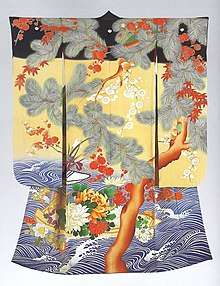Yūzen
Yūzen (友禅染) is a Japanese resist dyeing technique involving the application of rice paste to fabric to prevent colour transfer.

Originating in the 17th century, the technique became popular as both a way of subverting sumptuary laws on dress fabrics,[1] and also as a way to produce kimono that appeared to be hand-painted in a much shorter time period. The technique was named after Miyazaki Yūzen, a 17th-century fan painter who perfected the technique.

Present day
Moriguchi Kako of Kyoto has continued to create works of art in his yūzen-dyed kimono, which were so sought after that the contemporary fashion industry designed an industrial method to copy them for use on Western-style clothing. Famous designers, such as Hanae Mori, borrowed extensively from kimono patterns for their couturier collections. By the late 1980s, an elegant, handwoven, dyed kimono had become extremely costly, running to US$25,000 for a formal garment. In Okinawa the famous yūzen-dyeing method was especially effective where it was produced in the bingata stencil-dyeing techniques, which produced exquisitely colored, striking designs as artistic national treasures.
Other resist methods
Other methods of resist dyeing are rōketsuzome with wax, katazome and tsutsugaki with rice paste.[2]
Birodo yūzen, or yūzen birodo, describes velvet dyed and painted using the yūzen process where the pile is cut away in deep and light layers, creating a painterly effect of light and shade.[3] The technique first appeared in the nineteenth century and was described in 1905 by Basil Hall Chamberlain.[4] Although Chamberlain describes the technique under the heading of embroidery, birodo yūzen is not actually embroidered, but uses a cut-velvet technique to reproduce paintings and photographs.[4] Although technically a form of velvet painting, birodo yūzen works are not like the Western and Middle-Eastern velvet paintings which use velvet as a canvas.
References
- Condra, Jill (2008). The Greenwood Encyclopedia of Clothing Through World History. Greenwood Publishing Group. ISBN 9780313336645.
- http://www.kougei.or.jp/english/dyeing.html Association for the Promotion of Traditional Craft Industries. Accessed November 22, 2010.
- "Takeuchi Seiho (after), Moon over Venice, a textile wall hanging". British Museum. British Museum. Retrieved 24 August 2012.
- Chamberlain, Basil Hall (1905 (republished 28 February 2009)). Things Japanese : being notes on various subjects connected with Japan for the use of travellers and others. J. Murray, London (republished by Echo Press, 2009). ISBN 9781848301818. Check date values in:
|date=(help)
External links
